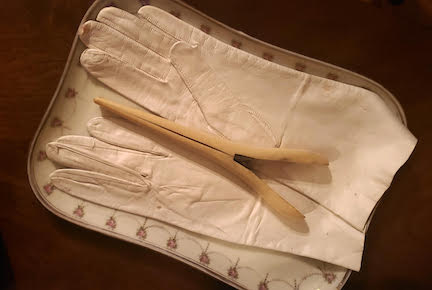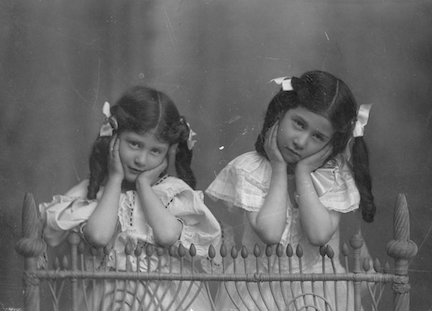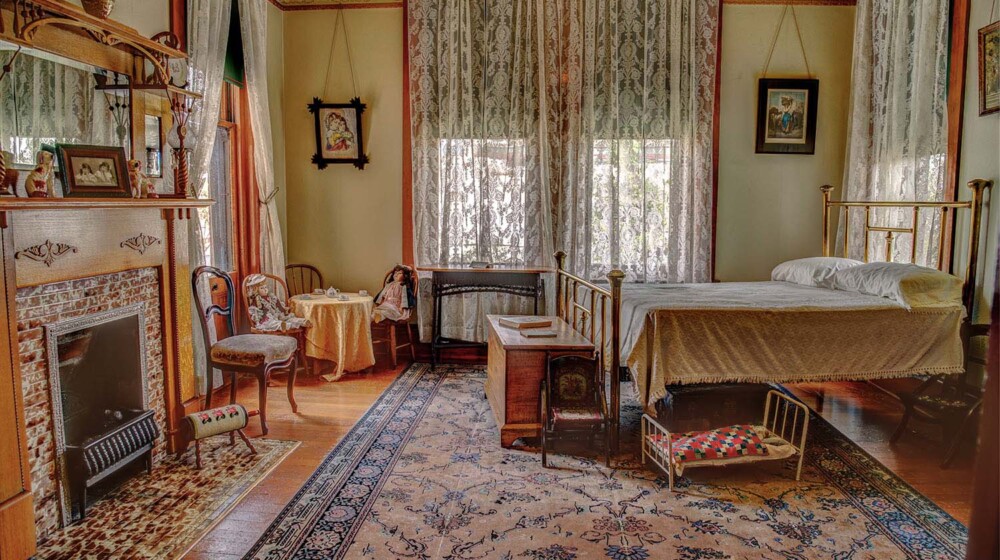The North Bedroom
 This is the largest bedroom, and the only one located on the north side of Rosson House. Though we don’t know for certain who used this room, at the time the House was built the biggest bedroom would often be shared by the children, so it’s possible the Rosson’s three daughters used this room, as may have the Goldberg’s two daughters, Hazel and Selma. During restoration, a corner sink was found to replace the more modern one in the room (the plumbing was original). Restorers didn’t believe the wallpaper found in this room was original to the home, so they chose to purchase an antique oatmeal paper instead (oatmeal paper = wallpaper with materials added to the paper fibers to create texture, usually sawdust, oatmeal, or cloth fragments).
This is the largest bedroom, and the only one located on the north side of Rosson House. Though we don’t know for certain who used this room, at the time the House was built the biggest bedroom would often be shared by the children, so it’s possible the Rosson’s three daughters used this room, as may have the Goldberg’s two daughters, Hazel and Selma. During restoration, a corner sink was found to replace the more modern one in the room (the plumbing was original). Restorers didn’t believe the wallpaper found in this room was original to the home, so they chose to purchase an antique oatmeal paper instead (oatmeal paper = wallpaper with materials added to the paper fibers to create texture, usually sawdust, oatmeal, or cloth fragments).
The wallpaper border is also antique and was purchased from the Brillion Wallpaper Collection, Wisconsin.
There are several interesting artifacts in this room that visitors want to know more about. Here are a few of our favorites, in alphabetical order (if there are any we’ve missed that you’d like to know more about, please let us know):
-
Doll
 This is a Heinrich Handwerck doll (with a pink dress and dark hair), made in Germany in the early 1900s. It’s made of bisque (bisque = unglazed china) and cloth, and was purchased by S.W. Higley in Chicago for his daughter, Jessie Jean (Higley) Lane between 1900 and 1905. It is one of the few family artifacts at Rosson House that is original to the home.
This is a Heinrich Handwerck doll (with a pink dress and dark hair), made in Germany in the early 1900s. It’s made of bisque (bisque = unglazed china) and cloth, and was purchased by S.W. Higley in Chicago for his daughter, Jessie Jean (Higley) Lane between 1900 and 1905. It is one of the few family artifacts at Rosson House that is original to the home.
-
Footstool
 This cylindrical footstool’s low height would give it just the right height to use as a footwarmer in front of a fireplace. The upholstery was created in 1988 by a Phoenix needlework club.
This cylindrical footstool’s low height would give it just the right height to use as a footwarmer in front of a fireplace. The upholstery was created in 1988 by a Phoenix needlework club.
-
Glove Stretcher
 Glove stretchers are often confused with period curling irons: Both open the same way, by squeezing a wide handle which opens a tapered end. Stretchers were inserted into the fingers of gloves (usually leather gloves which became stiff after not being used) and expanded to make putting gloves on easier and to reduce the risk of tearing gloves. Like many items from the time period, this glove stretcher is made of a turn-of-the-century plastic, like celluloid or cellulose, and created to imitate ivory, which was much more expensive.
Glove stretchers are often confused with period curling irons: Both open the same way, by squeezing a wide handle which opens a tapered end. Stretchers were inserted into the fingers of gloves (usually leather gloves which became stiff after not being used) and expanded to make putting gloves on easier and to reduce the risk of tearing gloves. Like many items from the time period, this glove stretcher is made of a turn-of-the-century plastic, like celluloid or cellulose, and created to imitate ivory, which was much more expensive.
-
Photograph
 This adorable photograph of Hazel and Selma Goldberg c1900 is a duplicate print; the original belongs to the Arizona State Library and Archives and can be found in the Arizona Memory Project online database. Other copies belong to the Arizona Jewish Historical Society.
This adorable photograph of Hazel and Selma Goldberg c1900 is a duplicate print; the original belongs to the Arizona State Library and Archives and can be found in the Arizona Memory Project online database. Other copies belong to the Arizona Jewish Historical Society.
Explore what life was like in schools here in Phoenix at the turn-of-the-century by reading our articles, Back to School and School’s Out. Learn about what Victorian Era kids played with before there were Legos in our article, Victorian Toys. Discover what other things were made of plastics in the late Victorian Era, including pool balls, hair combs, and movies, by reading our article Moving Picture.
La Recámara Norte
 Esta es la habitación más grande y la única ubicada en el lado norte de la Casa Rosson. Aunque no sabemos con certeza quién habitó esta recámara, durante la época en la que la casa fue construida, la habitación más grande a menudo era compartida por niños/as, así que es posible que las tres hijas Rosson hayas utilizado esta habitación, al igual que las dos hijas Goldberg, Hazel y Selma. Durante la restauración, un lavabo de esquina se adquirió para reemplazar el modelo más moderno que se encontraba en la habitación (la plomería era original). Los restauradores no creían que el papel tapiz que se encontraba en esta habitación fuera original, así que adquirieron un papel tapiz “avena” antiguo (papel “avena” = papel tapiz con materiales añadidos a las fibras de papel para crear textura, comúnmente aserrín, avena, o fragmentos de tela). El borde del papel tapiz también es antiguo y fue adquirido de la Colección Brillion de Papel Tapiz en Wisconsin.
Esta es la habitación más grande y la única ubicada en el lado norte de la Casa Rosson. Aunque no sabemos con certeza quién habitó esta recámara, durante la época en la que la casa fue construida, la habitación más grande a menudo era compartida por niños/as, así que es posible que las tres hijas Rosson hayas utilizado esta habitación, al igual que las dos hijas Goldberg, Hazel y Selma. Durante la restauración, un lavabo de esquina se adquirió para reemplazar el modelo más moderno que se encontraba en la habitación (la plomería era original). Los restauradores no creían que el papel tapiz que se encontraba en esta habitación fuera original, así que adquirieron un papel tapiz “avena” antiguo (papel “avena” = papel tapiz con materiales añadidos a las fibras de papel para crear textura, comúnmente aserrín, avena, o fragmentos de tela). El borde del papel tapiz también es antiguo y fue adquirido de la Colección Brillion de Papel Tapiz en Wisconsin.
Hay varios artefactos interesantes en esta sala sobre los que los visitantes quieren saber más. Aquí se encuentran algunos de nuestros favoritos, en orden alfabético (si hay alguno que no mencionamos y quisieras saber más acerca de él, por favor háganoslo saber):
-
Ensanchador de Guantes
 Los ensanchadores de guantes comúnmente se confunden con los rizadores de cabello de la época: ambos abren de la misma manera, al apretar la manija ancha, la cual abre el extremo puntiagudo. Los ensanchadores se introducían en los dedos de los guantes (normalmente los guantes de piel se endurecían después de no ser usados) y estiraban los guantes para facilitar la colocación de los guantes, y para reducir el riesgo de rasgarlos. Al igual que muchos artículos de la época, este ensanchador de guantes está hecho de un tipo de plástico antiguo, como celuloide o celulosa, y creado como imitación marfil, el cual era mucho más caro.
Los ensanchadores de guantes comúnmente se confunden con los rizadores de cabello de la época: ambos abren de la misma manera, al apretar la manija ancha, la cual abre el extremo puntiagudo. Los ensanchadores se introducían en los dedos de los guantes (normalmente los guantes de piel se endurecían después de no ser usados) y estiraban los guantes para facilitar la colocación de los guantes, y para reducir el riesgo de rasgarlos. Al igual que muchos artículos de la época, este ensanchador de guantes está hecho de un tipo de plástico antiguo, como celuloide o celulosa, y creado como imitación marfil, el cual era mucho más caro.
-
Fotografía
 Esta adorable fotografía de Hazel y Selma Goldberg de alrededor 1900 es una impresión duplicada; la original le pertenece a la Biblioteca y Archivos del Estado de Arizona y se encuentra en la base de datos en línea del Proyecto de Memoria de Arizona. Otras copias le pertenecen a la Sociedad Histórica Judía de Arizona.
Esta adorable fotografía de Hazel y Selma Goldberg de alrededor 1900 es una impresión duplicada; la original le pertenece a la Biblioteca y Archivos del Estado de Arizona y se encuentra en la base de datos en línea del Proyecto de Memoria de Arizona. Otras copias le pertenecen a la Sociedad Histórica Judía de Arizona.
-
Muñeca
 Esta es una muñeca Heinrich Handwerck (con vestido rosa y cabello oscuro), hecha en Alemania a principios de los 1900s. Está hecha de “bizcocho” (porcelana sin esmaltar) y tela, y fue adquirida por S.W. Higley en Chicago para su hija, Jessie Jean (Higley) Lane entre 1900 y 1905. Es uno de los pocos artefactos familiares originales de la Casa Rosson.
Esta es una muñeca Heinrich Handwerck (con vestido rosa y cabello oscuro), hecha en Alemania a principios de los 1900s. Está hecha de “bizcocho” (porcelana sin esmaltar) y tela, y fue adquirida por S.W. Higley en Chicago para su hija, Jessie Jean (Higley) Lane entre 1900 y 1905. Es uno de los pocos artefactos familiares originales de la Casa Rosson.
-
Taburete para pies
 La baja estatura de este taburete cilíndrico brindaba la altura ideal para utilizarse para calentar los pies frente a la chimenea. La tapicería fue creada en 1988 por un club de bordado de Phoenix.
La baja estatura de este taburete cilíndrico brindaba la altura ideal para utilizarse para calentar los pies frente a la chimenea. La tapicería fue creada en 1988 por un club de bordado de Phoenix.
Explora cómo era la vida escolar aquí en Phoenix a principios del siglo XX leyendo nuestros artículos, De Vuelta a Clases y La Escuela Terminó.
Descubre con qué jugaban los niños de la era victoriana antes de que existieran los Legos en nuestro artículo, Juguetes Victorianos.
Descubre qué otras cosas estaban hechas de plástico en la época Victoriana tardía, incluyendo bolas de billar, peines, y películas, leyendo nuestro artículo Imágenes en Movimiento.
Siguiente Página: La Recámara Trasera Volver a la Página Principal
